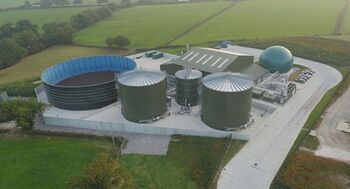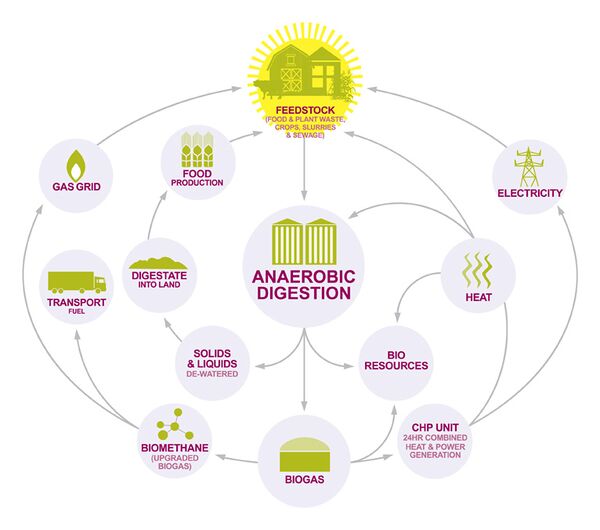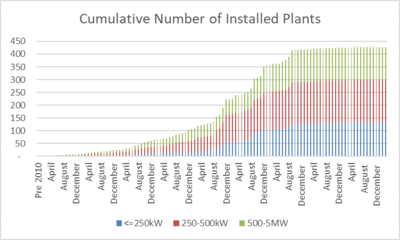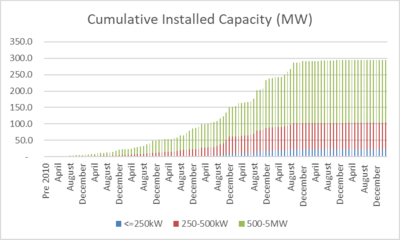Anaerobic Digestion: Difference between revisions
m minor text change |
m add page specific text |
||
| Line 6: | Line 6: | ||
==Overview== | ==Overview== | ||
'''Anaerobic Digestion''' (AD) is a process where biodegradable material is broken down by micro-organisms in the absence of oxygen in an enclosed vessel. [[Biogas]] is produced that can be used for the generation of power (electic and heat), or refined and used as a biomethane, and [[Digestate]] is produced which can be used as a biofertiliser. | '''Anaerobic Digestion''' (AD) is a process where biodegradable material is broken down by micro-organisms in the absence of oxygen in an enclosed vessel. [[Biogas]] is produced that can be used for the generation of power (electic and heat), or refined and used as a 'biomethane', and [[Digestate]] is produced which can be used as a 'biofertiliser'. | ||
The process of AD occurs in several stages and requires a community of micro-organisms: | The process of AD occurs in several stages and requires a community of micro-organisms: | ||
# Hydrolysis - large, complex polymers like carbohydrates, cellulose, proteins and fats are broken down by hydrolytic enzymes into simple sugars, amino acids and fatty acids. | # Hydrolysis - large, complex polymers like carbohydrates, cellulose, proteins and fats are broken down by hydrolytic enzymes into simple sugars, amino acids and fatty acids. | ||
| Line 16: | Line 16: | ||
===Feedstock=== | ===Feedstock=== | ||
Anaerobic Digestion uses biodegradable waste materials from a range of different sources | Anaerobic Digestion uses biodegradable waste materials from a range of different sources: | ||
* [[Food Waste]] | * [[Food Waste]] | ||
* [[Agricultural Waste]] such as manure and slurry | * [[Agricultural Waste]] such as manure and slurry | ||
* [[Sewage Sludge]] | * [[Sewage Sludge]] | ||
* Crops (including maize, grass | * Crops (including maize, grass silage, energy beet and whole crop cereals). | ||
AD plants tend to be broadly categorised into '''Food AD''' and '''Farm AD''' projects (the former being 'pure' [[Food Waste]] and the latter being either single stream (i.e. based on manures alone) or multi-streamed (i.e. based on a mix of crop and/or manure and/or [[Food Waste]]). [[Sewage Sludge]] doesn't tend to be blended with other materials and tends to be a dedicated AD solution in its own right - primarily as it becomes impossible to to deliver [[End of Waste Criteria|End of Waste]] compost with the introduction of [[Sewage Sludge]] as an input feedstock. In any event, where the process utilises [[Animal By-product Material]], it must comply with the [[Animal By-Products (Enforcement) (England) Regulations 2011]] requirements. | |||
In addition, AD projects are required to report on their [[Biomass Sustainability]] under the [ROC]], [[FIT]] and [[SEG]] schemes, which demonstrates sustainability of the [[biogas]] produced based upon: | In addition, AD projects are required to report on their '''[[Biomass Sustainability]]''' under the [[ROC]], [[FIT]] and [[SEG]] schemes, which demonstrates sustainability of the [[biogas]] produced based upon: | ||
* meeting greenhouse gas criteria and is made from solid biomass (i.e. | * meeting greenhouse gas criteria and is made from solid biomass (i.e. Farm AD based on a crop such as maize) that also meets the land criteria | ||
* is made from feedstock which is waste or | * is made from feedstock which is waste (i.e. Food AD) or | ||
* consists of both of the above. | * consists of both of the above (i.e. Farm AD that is multi-streamed). | ||
===Biogas=== | ===Biogas=== | ||
| Line 46: | Line 43: | ||
==Growth in Anaerobic Digestion== | ==Growth in Anaerobic Digestion== | ||
An analysis of the data provided by National Statistics<ref>https://www.gov.uk/government/statistics/monthly-small-scale-renewable-deployment</ref> for the monthly [[FIT]] commissioned installations over the period of the schemes existence shows an increase from 1 plant prior to 2010 to 427 plants by March 2019, generating 294.9MW of power. | |||
{| class="wikitable" | |||
|- | |||
| [[File:No. AD Plants Installed.png|400px|centre|Feed in Tariffs: Cumulative Number of Installations 2010 to 2019 - Generated from National Statistics data]] || [[File:AD MW Capacity Installed.png|400px|centre|Feed in Tariffs: Cumulative Capacity Installed 2010 to 2019 - Generated from National Statistics data]] | |||
|} | |||
The graphs show the slowing of the cumulative growth in capacity from late 2016, linked to a change in the amounts payable under the [[FIT]] scheme | |||
{| class="wikitable" | |||
|- | |||
! Capacity !! Cumulative Number of Plants Installed||% Split||Cumulative Capacity Installed(MW)||% Split | |||
|- | |||
| <=250kW ||133 ||31%||23.7||8% | |||
|- | |||
| 250-500kW || 166||39%||80.1||27% | |||
|- | |||
| 500-5MW || 128||30%||191.1||65% | |||
|- | |||
| Total || 427||100%||294.9||100% | |||
|} | |||
The table shows that by 2019, whilst the size of plants were relatively evenly distributed amongst the 3 bands of measurement/scales of plant, the larger scale projects had a disproportionally large installed capacity. | |||
==Number of UK Sites== | ==Number of UK Sites== | ||
Revision as of 13:12, 13 May 2020
Anaerobic Digestion (AD) is a process where biodegradable material is broken down by micro-organisms in the absence of oxygen in an enclosed vessel. The process produces a Biogas which can be used for generating renewable power and a nutrient-rich solid/liquor known as digestate which can be used as fertiliser and compost. Anaerobic Digestion uses biodegradable waste materials from Agricultural Waste such as manure and slurry, Food Waste and Sewage Sludge. Where the process utilises Animal By-product Material, it must comply with the Animal By-Products (Enforcement) (England) Regulations 2011 requirements.

Overview
Anaerobic Digestion (AD) is a process where biodegradable material is broken down by micro-organisms in the absence of oxygen in an enclosed vessel. Biogas is produced that can be used for the generation of power (electic and heat), or refined and used as a 'biomethane', and Digestate is produced which can be used as a 'biofertiliser'. The process of AD occurs in several stages and requires a community of micro-organisms:
- Hydrolysis - large, complex polymers like carbohydrates, cellulose, proteins and fats are broken down by hydrolytic enzymes into simple sugars, amino acids and fatty acids.
- Acidogenesis - simple monomers are broken down into volatile fatty acids
- Acetogenesis - the products of acidogenesis are broken down into acetic acid, releasing hydrogen and carbon dioxide.
- Methanogenesis - bacteria called methane formers produce methane either by cleaving two acetic acid molecules to form carbon dioxide and methane, or by reduction of carbon hydroxide with hydrogen [1]

Feedstock
Anaerobic Digestion uses biodegradable waste materials from a range of different sources:
- Food Waste
- Agricultural Waste such as manure and slurry
- Sewage Sludge
- Crops (including maize, grass silage, energy beet and whole crop cereals).
AD plants tend to be broadly categorised into Food AD and Farm AD projects (the former being 'pure' Food Waste and the latter being either single stream (i.e. based on manures alone) or multi-streamed (i.e. based on a mix of crop and/or manure and/or Food Waste). Sewage Sludge doesn't tend to be blended with other materials and tends to be a dedicated AD solution in its own right - primarily as it becomes impossible to to deliver End of Waste compost with the introduction of Sewage Sludge as an input feedstock. In any event, where the process utilises Animal By-product Material, it must comply with the Animal By-Products (Enforcement) (England) Regulations 2011 requirements.
In addition, AD projects are required to report on their Biomass Sustainability under the ROC, FIT and SEG schemes, which demonstrates sustainability of the biogas produced based upon:
- meeting greenhouse gas criteria and is made from solid biomass (i.e. Farm AD based on a crop such as maize) that also meets the land criteria
- is made from feedstock which is waste (i.e. Food AD) or
- consists of both of the above (i.e. Farm AD that is multi-streamed).
Biogas
The process produces a Biogas which is around 60% methane, 40% carbon dioxide and traces of other contaminant gas (depending on the feedstock being digested). Biogas can be combusted to provide heat, electricity, or both. Alternatively the Biogas can be 'upgraded' to pure methane, often called biomethane, by removing other gases. This pure stream of biomethane can then be injected it into the mains gas grid or used as a road fuel. One cubic metre of biogas at 60% methane content converts to 6.7 kWh energy[2].
Digestate
Digestate is a nutrient-rich substance produced by AD that can be used as a fertiliser. It consists of left over indigestible material and dead micro-organisms - the volume of digestate will be around 90-95% of what was fed into the digester. Digestate is not compost, although it has some similar characteristics. In order for the material to no longer be considered as waste and be used as a fertiliser, the digestate must meet the standards set out in the Quality protocol and PAS110[3] (SEPA position statement in Scotland[4])
Process Options
The process options are varied to manage the AD stages into the following classifications:
- Mesophilic or Thermophilic - operating at 25 to 45oC and 50 to 60oC respectively, the majority are Thermophilic in the UK
- Wet or dry
- Continuous or batch flow - the majority are continuous flow in the UK
- Single, double or multiple digesters - most are single or double in the UK and can manage the stages more efficiently
- Vertical tank or horizontal plug flow[5]
Growth in Anaerobic Digestion
An analysis of the data provided by National Statistics[6] for the monthly FIT commissioned installations over the period of the schemes existence shows an increase from 1 plant prior to 2010 to 427 plants by March 2019, generating 294.9MW of power.
The graphs show the slowing of the cumulative growth in capacity from late 2016, linked to a change in the amounts payable under the FIT scheme
| Capacity | Cumulative Number of Plants Installed | % Split | Cumulative Capacity Installed(MW) | % Split |
|---|---|---|---|---|
| <=250kW | 133 | 31% | 23.7 | 8% |
| 250-500kW | 166 | 39% | 80.1 | 27% |
| 500-5MW | 128 | 30% | 191.1 | 65% |
| Total | 427 | 100% | 294.9 | 100% |
The table shows that by 2019, whilst the size of plants were relatively evenly distributed amongst the 3 bands of measurement/scales of plant, the larger scale projects had a disproportionally large installed capacity.
Number of UK Sites
References
- ↑ http://www.biogas-info.co.uk/about/ad/
- ↑ http://www.biogas-info.co.uk/about/biogas/
- ↑ WRAP Website With Link to Download
- ↑ http://www.biofertiliser.org.uk/pdf/SEPA-Position-Statement.pdf
- ↑ http://www.biogas-info.co.uk/about/ad/
- ↑ https://www.gov.uk/government/statistics/monthly-small-scale-renewable-deployment


